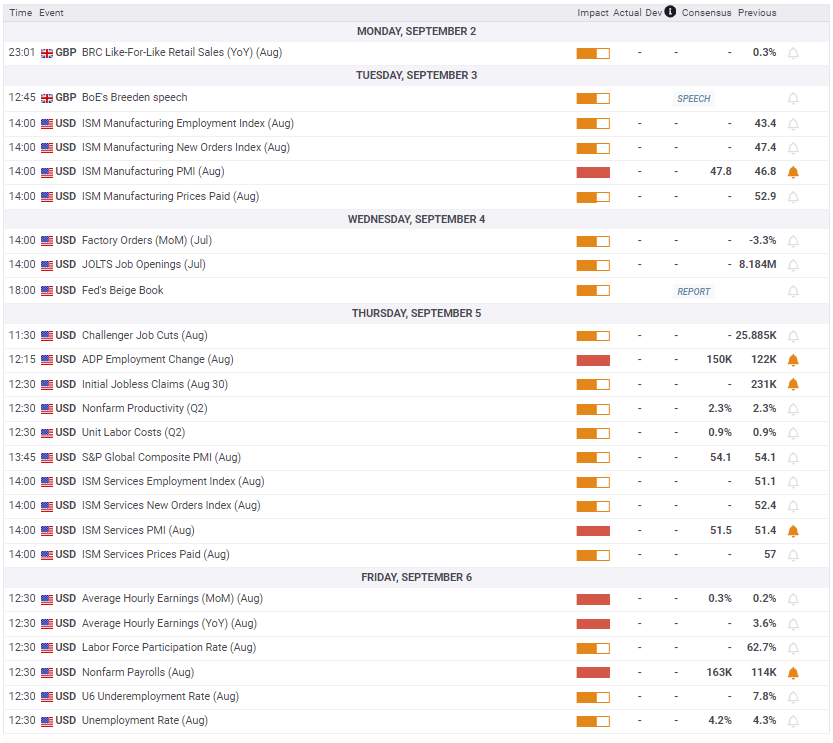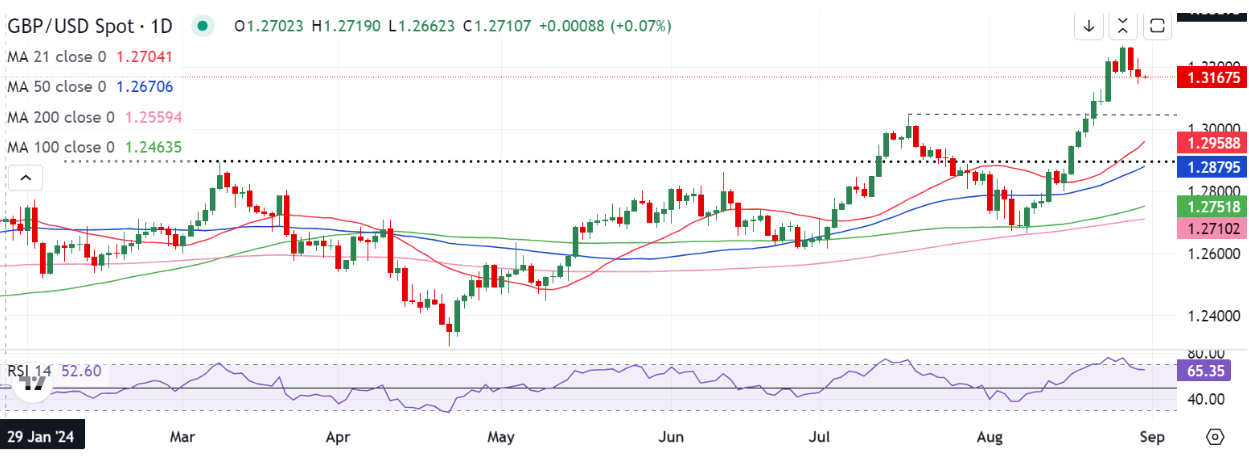- The Pound Sterling hit its highest in over two years against the US Dollar, then retreated.
- GBP/USD could extend the pullback on profit-taking ahead of key US employment data.
- The Pound Sterling has eased off the overbought territory on the daily RSI, but buyers look cautious.
The buying interest in the Pound Sterling (GBP) against the US Dollar (USD) remained unabated, sending the GBP/USD pair to a 29-month-high above 1.3250 before sellers fought back control in the second half of the week.
Pound Sterling witnessed good two-way business
GBP/USD extended the previous week’s winning momentum and recorded a 29-month high at 1.3266, as the US Dollar downside gathered steam in the early part of the week. US Federal Reserve (Fed) Chairman Jerome Powell’s dovish remarks at the Jackson Hole Symposium on August 23 continued to ramp up dovish expectations surrounding potential interest-rate cuts later this year, exacerbating the pain in the USD.
Powell clearly confirmed that the Fed’s easing cycle will begin in September, noting that "the time has come for policy to adjust. The direction of travel is clear, and the timing and pace of rate cuts will depend on incoming data, the evolving outlook, and the balance of risks." The US Dollar Index (DXY) reached its lowest in thirteen months on Tuesday, despite the resilience shown by the US Treasury bond yields amid strong government bond auctions.
Escalating geopolitical tensions between Israel and Iran also failed to lift the haven demand for the Greenback. Israel launched a preemptive airstrike on Hezbollah in southern Lebanon on Sunday, reportedly using 100 jet fighters to hit 40 locations, as Hezbollah was said to launch a large-scale missile and rocket attack on northern and central Israel with the intended target being Mossad, the Israeli spy agency.
The tide, however, turned in favor of USD buyers after Atlanta Fed President Raphael Bostic pushed back against the first rate cut likely in September, noting that “inflation has come down faster than expected, unemployment has risen farther than thoughts. This means we should pull forward rate cut to third-quarter.”
Further, a sell-off in tech stocks due to the disappointing sales forecast by American AI giant, Nvidia, infused safe-haven flows into the US Dollar, triggering a fresh correction in GBP/USD from almost multi-year highs. Additionally, increased bets for a rate cut in September by the European Central Bank (ECB) fuelled a EUR/USD sell-off, providing extra legs to the US Dollar upswing at the expense of the Pound Sterling.
The upward revision to the US second-quarter Gross Domestic Product (GDP) data on Thursday also contributed to the renewed optimism around the US Dollar, as the GBP/USD pair gave up the 1.3200 threshold.
The US economy grew last quarter at an annual pace of 3%, fueled by strong consumer spending and business investment, an upgrade to the government’s initial reading of 2.8%. Markets now price in only 33% odds of a 50 basis point (bp) cut next month, down from 38% seen at the start of the week, according to the CME Group's FedWatch Tool.
The pair languished in weekly lows on the week's final trading day, with traders unnerved ahead of the high-impact US core Personal Consumption Expenditures (PCE) Price Index, the Fed’s preferred inflation gauge.
On a yearly basis, the PCE Price Index rose 2.5%, the US Bureau of Economic Analysis (BEA) reported on Friday. This reading came in below the market expectation of 2.6%. The core PCE Price Index, which excludes volatile food and energy prices, increased 2.6% in the same period, matching June's increase and coming in below the market forecast of 2.7%. The core PCE Price Index rose 0.2% on a monthly basis, as anticipated. July PCE inflation figures failed to trigger a market reaction and made it difficult for GBP/USD to stage a rebound.
US Nonfarm Payrolls to stand out in the holiday-shortened week
Another holiday-shortened week is in the offing, as the United States (US) observes Labor Day on Monday. There is nothing of note from the United Kingdom (UK) docket on that day, except for the final S&P Global Manufacturing PMI.
It’s a data-sparse economic calendar in the UK in the week ahead. In contrast, the high-impact US employment data will trickle in from Wednesday, with the all-important US Nonfarm Payrolls data slated for release on Friday.
Earlier in the week, the US ISM Manufacturing PMI will be reported on Tuesday. Meanwhile, the US JOLTS Job Openings survey will drop on Wednesday.
The usual weekly Jobless Claims from the US will be published after the ADP Employment Change data, followed by the ISM Services PMI.
Apart from the data releases, GBP/USD traders will keep a close eye on the sentiment around the central banks’ policy expectations, speeches from Fed officials and Middle East geopolitical risks.
GBP/USD: Technical Outlook
The GBP/USD pair remains poised for further upside but a brief correction could be in the offing, in the wake of the relentless rise seen this month.
Should the pullback extend into the upcoming week, the July 17 high of 1.3045 will be challenged initially. A failure to sustain above that level could trigger a fresh decline toward the 21-day Simple Moving Average (SMA) at 1.2959.
The next relevant cushion is seen at the March 8 top of 1.2894, which coincides with the 50-day SMA, making it a healthy support level.
Only a firm break below the latter will accelerate the downside toward the critical confluence demand area near 1.2730, where the 100-day and 200-day SMAs hang around.
However, with the 14-day Relative Strength Index (RSI) still well above the 50 level, any corrective pullback in GBP/USD could be seen as a good ‘dip-buying’ opportunity.
On the upside, GBP/USD could meet interim resistance at 1.3250 before the 29-month high of 1.3266 will be retested.
Further up, Pound Sterling buyers will aim for the 1.3300 round level and the 1.3350 psychological barrier.
Pound Sterling FAQs
The Pound Sterling (GBP) is the oldest currency in the world (886 AD) and the official currency of the United Kingdom. It is the fourth most traded unit for foreign exchange (FX) in the world, accounting for 12% of all transactions, averaging $630 billion a day, according to 2022 data. Its key trading pairs are GBP/USD, aka ‘Cable’, which accounts for 11% of FX, GBP/JPY, or the ‘Dragon’ as it is known by traders (3%), and EUR/GBP (2%). The Pound Sterling is issued by the Bank of England (BoE).
The single most important factor influencing the value of the Pound Sterling is monetary policy decided by the Bank of England. The BoE bases its decisions on whether it has achieved its primary goal of “price stability” – a steady inflation rate of around 2%. Its primary tool for achieving this is the adjustment of interest rates. When inflation is too high, the BoE will try to rein it in by raising interest rates, making it more expensive for people and businesses to access credit. This is generally positive for GBP, as higher interest rates make the UK a more attractive place for global investors to park their money. When inflation falls too low it is a sign economic growth is slowing. In this scenario, the BoE will consider lowering interest rates to cheapen credit so businesses will borrow more to invest in growth-generating projects.
Data releases gauge the health of the economy and can impact the value of the Pound Sterling. Indicators such as GDP, Manufacturing and Services PMIs, and employment can all influence the direction of the GBP. A strong economy is good for Sterling. Not only does it attract more foreign investment but it may encourage the BoE to put up interest rates, which will directly strengthen GBP. Otherwise, if economic data is weak, the Pound Sterling is likely to fall.
Another significant data release for the Pound Sterling is the Trade Balance. This indicator measures the difference between what a country earns from its exports and what it spends on imports over a given period. If a country produces highly sought-after exports, its currency will benefit purely from the extra demand created from foreign buyers seeking to purchase these goods. Therefore, a positive net Trade Balance strengthens a currency and vice versa for a negative balance.
Information on these pages contains forward-looking statements that involve risks and uncertainties. Markets and instruments profiled on this page are for informational purposes only and should not in any way come across as a recommendation to buy or sell in these assets. You should do your own thorough research before making any investment decisions. FXStreet does not in any way guarantee that this information is free from mistakes, errors, or material misstatements. It also does not guarantee that this information is of a timely nature. Investing in Open Markets involves a great deal of risk, including the loss of all or a portion of your investment, as well as emotional distress. All risks, losses and costs associated with investing, including total loss of principal, are your responsibility. The views and opinions expressed in this article are those of the authors and do not necessarily reflect the official policy or position of FXStreet nor its advertisers. The author will not be held responsible for information that is found at the end of links posted on this page.
If not otherwise explicitly mentioned in the body of the article, at the time of writing, the author has no position in any stock mentioned in this article and no business relationship with any company mentioned. The author has not received compensation for writing this article, other than from FXStreet.
FXStreet and the author do not provide personalized recommendations. The author makes no representations as to the accuracy, completeness, or suitability of this information. FXStreet and the author will not be liable for any errors, omissions or any losses, injuries or damages arising from this information and its display or use. Errors and omissions excepted.
The author and FXStreet are not registered investment advisors and nothing in this article is intended to be investment advice.
Recommended Content
Editors’ Picks

AUD/USD: A challenge of the 2025 peaks looms closer
AUD/USD rose further, coming closer to the key resistance zone around 0.6400 despite the strong rebound in the Greenback and the mixed performance in the risk-associated universe. The pair’s solid price action was also propped up by a firm jobs report in Oz.

EUR/USD: Extra gains likely above 1.1400
EUR/USD came under renewed downside pressure following another bull run to the 1.1400 region on Thursday. The knee-jerk in spot came in response to the decent bounce in the US Dollar, while the dovish tone from the ECB’s Lagarde seems to have also contributed to the bearish developments in the pair.

Gold bounces off daily lows, back near $3,320
The prevailing risk-on mood among traders challenges the metal’s recent gains and prompts a modest knee-jerk in its prices on Thursday. After bottoming out near the $3,280 zone per troy ounce, Gold prices are now reclaiming the $3,320 area in spite of the stronger Greenback.

Canada launches world's first Solana ETF as $270M in staking deposits propel SOL price above BTC and ETH
Solana price jumps on Thursday as Canadian firm launches the world’s first SOL ETF, fueling bullish sentiment alongside $270 million in new staking deposits this week.

Future-proofing portfolios: A playbook for tariff and recession risks
It does seem like we will be talking tariffs for a while. And if tariffs stay — in some shape or form — even after negotiations, we’ll likely be talking about recession too. Higher input costs, persistent inflation, and tighter monetary policy are already weighing on global growth.

The Best brokers to trade EUR/USD
SPONSORED Discover the top brokers for trading EUR/USD in 2025. Our list features brokers with competitive spreads, fast execution, and powerful platforms. Whether you're a beginner or an expert, find the right partner to navigate the dynamic Forex market.

